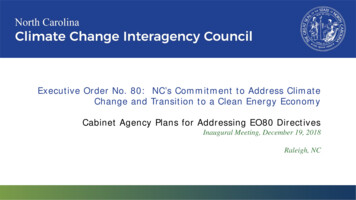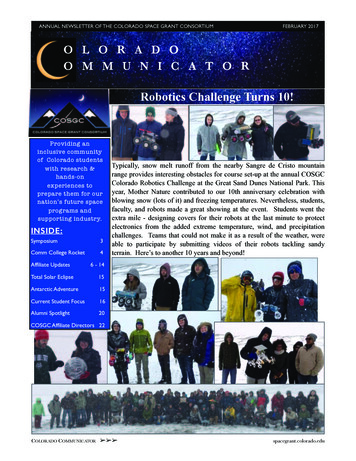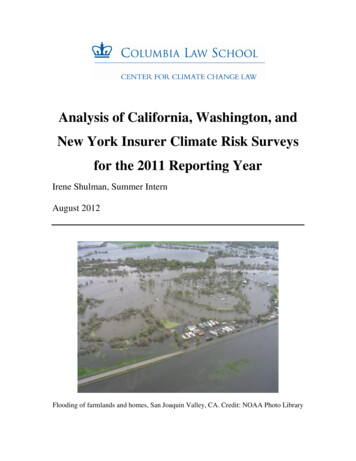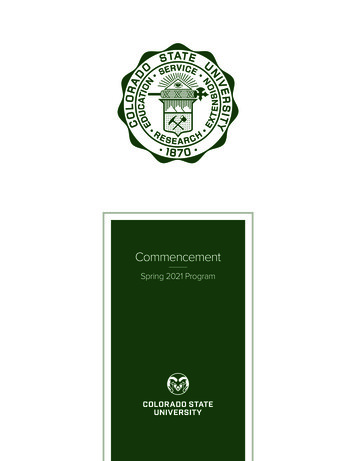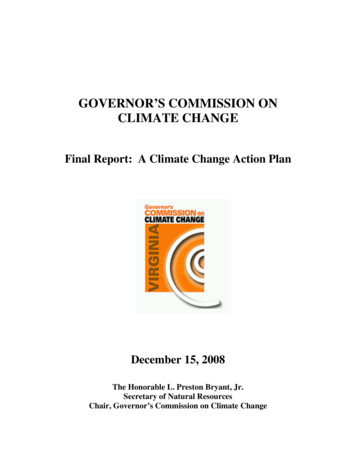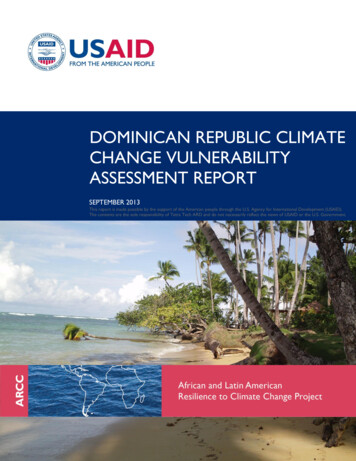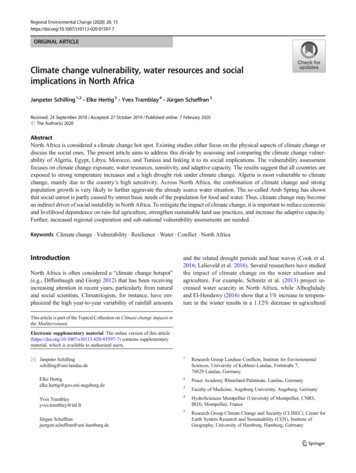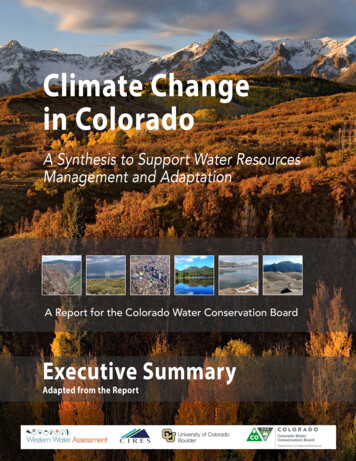
Transcription
Climate Changein ColoradoA Synthesis to Support Water ResourcesManagement and AdaptationA Report for the Colorado Water Conservation BoardExecutive SummaryAdapted from the Report
CLIMATE CHANGE IN COLORADOClimate Change in ColoradoA Synthesis to Support Water Resources Management and AdaptationSecond Edition - August 2014A Report for the Colorado Water Conservation BoardWestern Water Assessment, Cooperative Institute for Research in EnvironmentalSciences (CIRES), University of Colorado BoulderLead AuthorJeff Lukas, University of Colorado Boulder, CIRES Western Water AssessmentAuthorsJoseph Barsugli, University of Colorado Boulder, CIRESNolan Doesken, Colorado State University, Colorado Climate CenterImtiaz Rangwala, University of Colorado Boulder, CIRES Western Water AssessmentKlaus Wolter, University of Colorado Boulder, CIRESCopyright 2014 University of Colorado BoulderFunding for this report was provided by the Colorado Water Conservation Board, andby the Western Water Assessment through a grant from the NOAA Climate ProgramOfficeWe offer special thanks to those individuals who lent their time and expertise to reviewing orotherwise contributing to one or more of the sections of the reportDesign and LayoutAmi Nacu-Schmidt and Nancy Filice, CIRES Center for Science and Technology Policy ResearchFiguresJeff Lukas and Imtiaz RangwalaCover PhotosBackground photo (Dallas Divide, San Juan Mountains): iStock, kjschoenThumbnail photos (left to right): Creative Commons, Tim Engleman; Jeff Lukas; CreativeCommons, X-Weinzar; Creative Commons, Daniel Mayer (Mav); Jeff Lukas; Creative Commons,Geüpload door H-sttA Synthesis to Support Water Resources Management and Adaptationi
EXECUTIVE SUMMARYExecutive SummaryThis report is a synthesis of climate science relevantfor management and planning for Colorado’s waterresources. It focuses on observed climate trends,climate modeling, and projections of temperature,precipitation, snowpack, and streamflow. Climateprojections are reported for the mid-21st centurybecause this time frame is the focus of adaptationstrategies being developed by the State of Coloradoand other water entities.OverviewIn the past 30 years, Colorado’s climate has becomesubstantially warmer. The recent warming trend inColorado is in step with regional and global warmingthat has been linked to increasing atmosphericconcentrations of greenhouse gases. Annualprecipitation, which has high natural variability, hasnot seen a statewide trend over that period. However,some drought indicators have worsened due to thewarmer temperatures.As greenhouse gases and other human effects on theclimate continue to increase, Colorado is expected towarm even more by the mid-21st century, pushingtemperatures outside of the range of the past century.The outlook for future precipitation in Colorado is lessclear; overall increases or decreases are possible. Therisk of decreasing precipitation appears to be higherfor the southern parts of the state.The future warming is projected to generally reduceColorado’s spring snowpack, cause earlier snowmeltand runoff, and increase the water use by crops,landscaping, and natural vegetation. While futureincreases in annual natural streamflow are possible,the body of published research indicates a greater riskof decreasing streamflow, particularly in the southernhalf of the state.Summit Lake Park, along Mount Evans Scenic Byway.Photo: Creative Commons, Matt Wright.1
CLIMATE CHANGE IN COLORADOObserved climate trends inColorado (Section 2) Statewide annual average temperatures haveincreased by 2.0 F over the past 30 years and 2.5 Fover the past 50 years (Figure ES-1). Warmingtrends have been observed over these periods inmost parts of the state. Daily minimum temperatures in Colorado havewarmed more than daily maximum temperaturesduring the past 30 years. Temperatures haveincreased in all seasons. No long-term trends in average annual precipitationhave been detected across Colorado, evenconsidering the relatively dry period since 2000. Snowpack, as measured by April 1 snow-waterequivalent (SWE), has been mainly below-averagesince 2000 in all of Colorado’s river basins, but nolong-term (30-year, 50-year) declining trends havebeen detected. The timing of snowmelt and peak runoff has shiftedearlier in the spring by 1–4 weeks across Colorado’sriver basins over the past 30 years, due to thecombination of lower SWE since 2000, the warmingtrend in spring temperatures, and enhanced solarabsorption from dust-on-snow. The Palmer Drought Severity Index (PDSI) shows atrend towards more severe soil-moisture droughtconditions in Colorado over the past 30 years,reflecting the combination of the below-averageprecipitation since 2000 and the warming trend. No long-term statewide trends in heavy precipitationevents have been detected. The evidence suggeststhat there has been no statewide trend in themagnitude of flood events in Colorado.FIGURE ES-1. Colorado statewide annual temperature, 1900–2012Fig. ES-1. Colorado statewide annually-averaged temperature ( F), 1900–2012. Annual departures are shown relative toa 1971–2000 reference period. The light-orange, orange, and red lines are the 100-year, 50-year, and 30-year trends,respectively. All three warming trends are statistically significant. The gray line shows the 10-year running average. Therecord shows a cool period from 1900 to 1930, a warm period in the 1930s and again in the 1950s, a cool period in thelate 1960s and 1970s, and consistently warm temperatures since the mid-1990s. (Data source: NOAA NCDC; http://www.ncdc.noaa.gov/cag/)A Synthesis to Support Water Resources Management and Adaptation2
EXECUTIVE SUMMARY Tree-ring records and other paleoclimate indicatorsfor Colorado show multiple droughts prior to 1900that were more severe and sustained than any inthe observed record.Linking changes in Colorado toglobal changes (Section 4) The global climate system has warmed since 1900,particularly in the past 30 years, as evidencedby increased surface, atmospheric, and oceantemperatures; melting glaciers and ice sheets; risingsea levels; and increased atmospheric water vapor. These global changes have been attributed mainly toanthropogenic (human-caused) influences, primarilythe increase in greenhouse gases in the atmosphereto the highest levels in at least 800,000 years. In North America, temperatures have increased byabout 2 F in the last 30 years, with anthropogenicinfluences making a substantial contribution. In Colorado, temperatures have also warmed by2 F in the past 30 years. The statewide warming isplausibly linked to anthropogenic influences, butdefinitive attribution at this spatial scale is difficult. Recent variability in Colorado’s annual precipitationhas not exhibited trends that might be attributed toanthropogenic climate change. Anthropogenic climate change may have increasedthe severity of recent drought conditions in thewestern U.S., due to the influence of the warming onsnowpack, streamflow, and soil moisture.Projections of Colorado’s futureclimate and implications for waterresources (Section 5) All climate model projections indicate futurewarming in Colorado (Figure ES-2). The statewideaverage annual temperatures are projected to warmby 2.5 F to 5 F by 2050 relative to a 1971–2000baseline under a medium-low emissions scenarioFIGURE ES-2. Projected annual temperature and precipitation changes for the western U.S. for 2050Fig. ES-2. Projected changes in annual average temperature and precipitation by 2050 (2035–2064) over the western USfrom an ensemble of 37 climate models under RCP 4.5, a medium-low emissions scenario. The large maps show the averagechange for all of the models (n 37), and the small maps show the average changes for the highest 20% (n 8) and lowest20% (n 8) of the models, based on the statewide change for Colorado. For Colorado, all models show substantial warming,but there is less agreement about the direction of precipitation change. See Figure 5-1 for an expanded version that alsoshows seasonal changes. (Data source: CMIP5 projections re-gridded to 1-degree grid, Reclamation 2013; http://gdo-dcp.ucllnl.org/)3
CLIMATE CHANGE IN COLORADO(RCP 4.5). Under a high emissions scenario (RCP8.5), the projected warming is larger at mid-century( 3.5 F to 6.5 F), and much larger later in thecentury as the two scenarios diverge. Summer temperatures are projected to warmslightly more than winter temperatures. Typicalsummer temperatures by 2050 are projected underRCP 4.5 to be similar to the hottest summers thathave occurred in past 100 years. Climate model projections show less agreementregarding future precipitation change for Colorado.The individual model projections of change by 2050in statewide annual precipitation under RCP 4.5range from -5% to 6% (Figure ES-2). Projectionsunder RCP 8.5 show a similar range of future change(-3% to 8%). Nearly all of the projections indicate increasingwinter precipitation by 2050. There is weakerconsensus among the projections regardingprecipitation in the other seasons. In the first projections of future Colorado hydrologybased on the latest climate model output, mostprojections show decreases in annual streamflow by2050 for the San Juan and Rio Grande basins. Theprojections are more evenly split between futureincreases and decreases in streamflow by 2050 forthe Colorado Headwaters, Gunnison, Arkansas,and South Platte basins. However, other hydrologyprojections show drier outcomes for Colorado, andthe overall body of published research indicatesa tendency towards future decreases in annualstreamflow for all of Colorado’s river basins. The peak of the spring runoff is projected to shift1–3 weeks earlier by the mid-21st century dueto warming. Late-summer flows are projected todecrease as the peak shifts earlier. Changes in thetiming of runoff are more certain than changes inthe amount of runoff. Most projections of Colorado’s spring snowpack(April 1 SWE) show declines for the mid-21st centurydue to the projected warming.EXECUTIVE SUMMARY Most climate projections indicate that heat waves,droughts and wildfires will increase in frequency andseverity in Colorado by the mid-21st century due tothe projected warming.Incorporating climate changeinformation into vulnerabilityassessment and planning (Section 6) Colorado water entities have been at the forefrontof incorporating climate change into long-termplanning, and their experience can inform futureefforts by others. Observed records of climate and hydrology arestill fundamental to assessing future climate risk,but should be supplemented with informationfrom climate model projections and paleoclimaterecords. Planning approaches that explore multiple futures,rather than assuming a single future trajectory, aremore compatible with climate projections and mayimprove preparedness for a changing climate. The uncertainty in projections of precipitation andstreamflow for Colorado should not be construedas a “no change” scenario, but instead as abroadening of the range of possible futures, someof which would present serious challenges to thestate’s water systems (Table ES-1).To download the full report, go nge/Supplemental information is available at:http://wwa.colorado.edu/climate/co2014report/A Synthesis to Support Water Resources Management and Adaptation4
EXECUTIVE SUMMARYTABLE ES-1. Summary of projected changes and potential impacts to water resources for ColoradoElementOverall surfacewater supplyProjected changes and potential impactsMost projections of future hydrology for Colorado’s riverbasins show decreasing annual runoff and less overallwater supply, but some projections show increasingrunoff. Warming temperatures could continue therecent trend towards earlier peak runoff and lower latesummer flows.Studies that have assessed thisvulnerability for ColoradoCWCB (2012); Reclamation(2012); Woodbury et al. (2012)Water infrastructure Changes in the snowpack and in streamflow timingoperationscould affect reservoir operations, including floodcontrol and storage. Changes in the timing andmagnitude of runoff could affect the functioning ofdiversion, storage, and conveyance structures.CWCB (2012); Reclamation(2012)Crop waterdemand, outdoorurban wateringWarming temperatures could increase the loss of waterfrom plants and soil, lengthen growing seasons, andincrease overall water demand.CWCB (2012); Reclamation(2012)Legal watersystemsEarlier and/or lower runoff could complicate theadministration of water rights and interstate watercompacts, and could affect which rights holders receivewater.CWCB (2012)Water qualityWarmer water temperatures could cause manyindicators of water quality to decline. Lower streamflowscould lead to increasing concentrations of pollutants.EPA (2013)GroundwaterresourcesGroundwater usage for agriculture could increase withwarmer temperatures. Changes in precipitation couldaffect groundwater recharge rates.Warmer temperatures could place higher demands onhydropower facilities for peaking power in summer.Energy demandWarmer lake and stream temperatures, and earlierand operating costsrunoff, could affect water use for cooling power plantsand in other industries.Macknick et al. (2012)Warmer temperatures could increase the frequency andForest disturbancesseverity of wildfire, and make trees more vulnerablein headwatersto insect infestation. Both have implications for waterregionsquality and watershed health.Riparian habitatsand fisheriesWarmer stream temperatures could have direct andindirect effects on aquatic ecosystems, including thespread of non-native species and diseases to higherelevations. Changes in streamflow timing could alsoaffect riparian ecosystems.Rieman and Isaak (2010)Water- and snowbased recreationEarlier streamflow timing could affect rafting and fishing.Changes in reservoir storage could affect recreationon-site and downstream. Declining snowpacks couldimpact winter mountain recreation and tourism.Reclamation (2012); Battaglinet al. (2011); Lazar and Williams(2008)Table ES-1. Potential water-related impacts from climate change in different areas and sectors. See the References sectionof the full report for the studies cited in the last column.5
To download the full report, go nge/Supplemental information is available at:http://wwa.colorado.edu/climate/co2014report/
This report is a synthesis of climate science relevant for management and planning for Colorado's water resources. It focuses on observed climate trends, climate modeling, and projections of temperature, precipitation, snowpack, and streamflow. Climate projections are reported for the mid-21st century

